LUDF Case Study: Dairy Farm Development, Management & Policies
VerifiedAdded on 2023/04/24
|9
|1770
|220
Report
AI Summary
This report provides a comprehensive analysis of the Lincoln University Dairy Farm (LUDF), focusing on its resources, activities, and management policies. It details the farm's resources, including land, cattle, and financial assets, and summarizes the main demonstration activities undertaken to improve farming practices and environmental sustainability. The report explores the reasons behind the dairy farm's development, the necessary infrastructure (paddock layout, roadways, fencing, and water systems), and the associated costs. An annual calendar of major management operations is presented, along with a description of key pasture and herd management policies aimed at optimizing pasture quality, herd nutrition, and overall farm productivity. The conclusion emphasizes the importance of effective planning and implementation for the continued success and development of LUDF's dairy farming system.
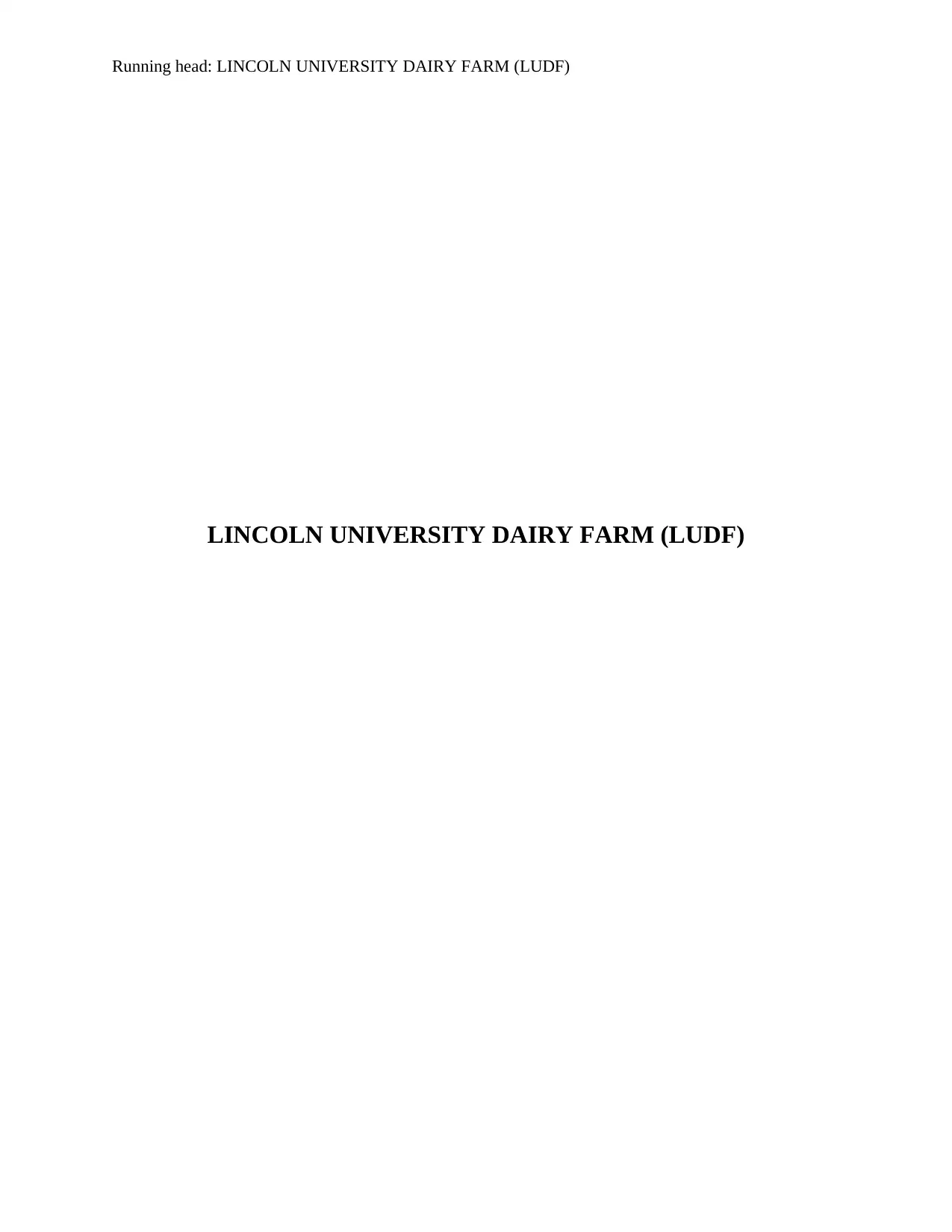
Running head: LINCOLN UNIVERSITY DAIRY FARM (LUDF)
LINCOLN UNIVERSITY DAIRY FARM (LUDF)
LINCOLN UNIVERSITY DAIRY FARM (LUDF)
Paraphrase This Document
Need a fresh take? Get an instant paraphrase of this document with our AI Paraphraser
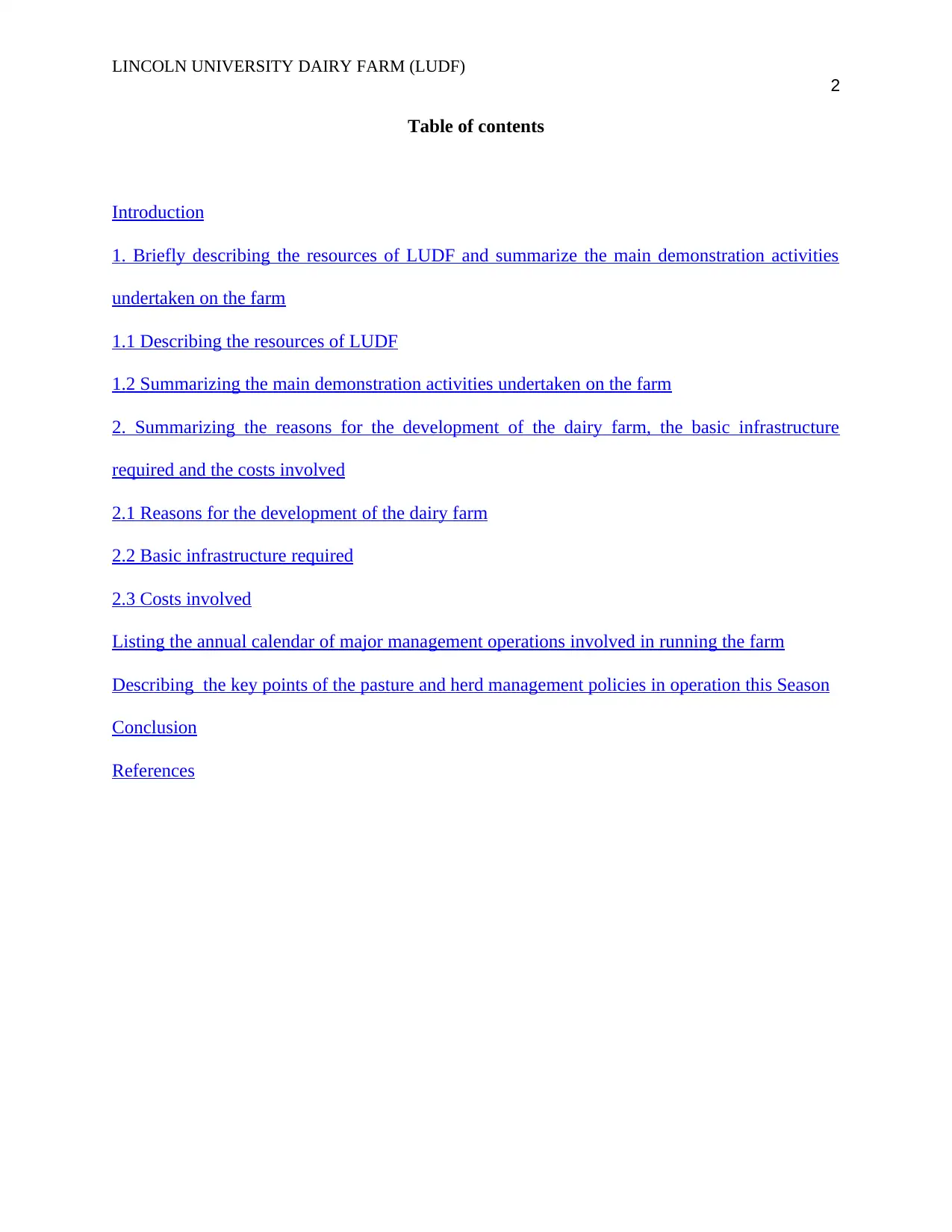
LINCOLN UNIVERSITY DAIRY FARM (LUDF)
2
Table of contents
Introduction
1. Briefly describing the resources of LUDF and summarize the main demonstration activities
undertaken on the farm
1.1 Describing the resources of LUDF
1.2 Summarizing the main demonstration activities undertaken on the farm
2. Summarizing the reasons for the development of the dairy farm, the basic infrastructure
required and the costs involved
2.1 Reasons for the development of the dairy farm
2.2 Basic infrastructure required
2.3 Costs involved
Listing the annual calendar of major management operations involved in running the farm
Describing the key points of the pasture and herd management policies in operation this Season
Conclusion
References
2
Table of contents
Introduction
1. Briefly describing the resources of LUDF and summarize the main demonstration activities
undertaken on the farm
1.1 Describing the resources of LUDF
1.2 Summarizing the main demonstration activities undertaken on the farm
2. Summarizing the reasons for the development of the dairy farm, the basic infrastructure
required and the costs involved
2.1 Reasons for the development of the dairy farm
2.2 Basic infrastructure required
2.3 Costs involved
Listing the annual calendar of major management operations involved in running the farm
Describing the key points of the pasture and herd management policies in operation this Season
Conclusion
References
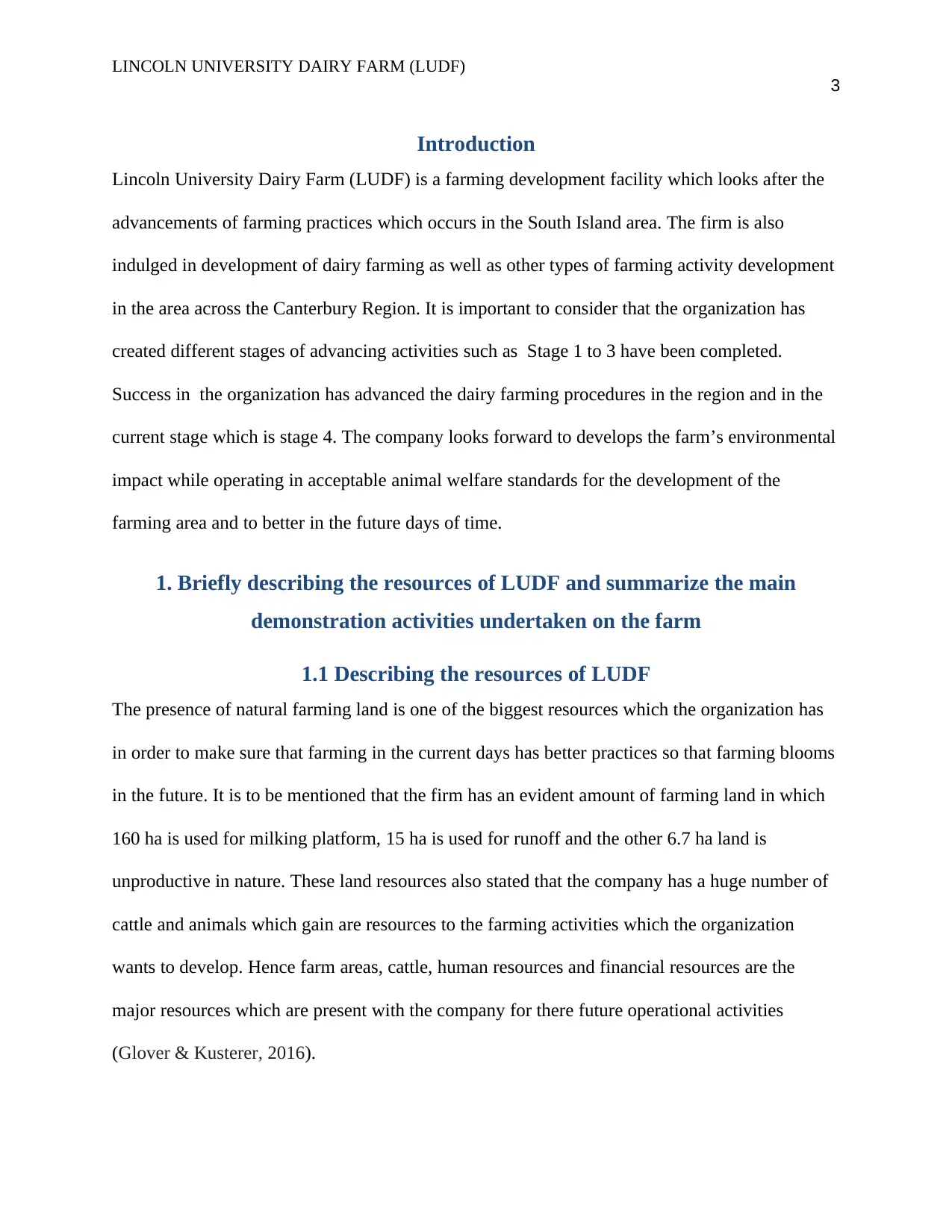
LINCOLN UNIVERSITY DAIRY FARM (LUDF)
3
Introduction
Lincoln University Dairy Farm (LUDF) is a farming development facility which looks after the
advancements of farming practices which occurs in the South Island area. The firm is also
indulged in development of dairy farming as well as other types of farming activity development
in the area across the Canterbury Region. It is important to consider that the organization has
created different stages of advancing activities such as Stage 1 to 3 have been completed.
Success in the organization has advanced the dairy farming procedures in the region and in the
current stage which is stage 4. The company looks forward to develops the farm’s environmental
impact while operating in acceptable animal welfare standards for the development of the
farming area and to better in the future days of time.
1. Briefly describing the resources of LUDF and summarize the main
demonstration activities undertaken on the farm
1.1 Describing the resources of LUDF
The presence of natural farming land is one of the biggest resources which the organization has
in order to make sure that farming in the current days has better practices so that farming blooms
in the future. It is to be mentioned that the firm has an evident amount of farming land in which
160 ha is used for milking platform, 15 ha is used for runoff and the other 6.7 ha land is
unproductive in nature. These land resources also stated that the company has a huge number of
cattle and animals which gain are resources to the farming activities which the organization
wants to develop. Hence farm areas, cattle, human resources and financial resources are the
major resources which are present with the company for there future operational activities
(Glover & Kusterer, 2016).
3
Introduction
Lincoln University Dairy Farm (LUDF) is a farming development facility which looks after the
advancements of farming practices which occurs in the South Island area. The firm is also
indulged in development of dairy farming as well as other types of farming activity development
in the area across the Canterbury Region. It is important to consider that the organization has
created different stages of advancing activities such as Stage 1 to 3 have been completed.
Success in the organization has advanced the dairy farming procedures in the region and in the
current stage which is stage 4. The company looks forward to develops the farm’s environmental
impact while operating in acceptable animal welfare standards for the development of the
farming area and to better in the future days of time.
1. Briefly describing the resources of LUDF and summarize the main
demonstration activities undertaken on the farm
1.1 Describing the resources of LUDF
The presence of natural farming land is one of the biggest resources which the organization has
in order to make sure that farming in the current days has better practices so that farming blooms
in the future. It is to be mentioned that the firm has an evident amount of farming land in which
160 ha is used for milking platform, 15 ha is used for runoff and the other 6.7 ha land is
unproductive in nature. These land resources also stated that the company has a huge number of
cattle and animals which gain are resources to the farming activities which the organization
wants to develop. Hence farm areas, cattle, human resources and financial resources are the
major resources which are present with the company for there future operational activities
(Glover & Kusterer, 2016).
⊘ This is a preview!⊘
Do you want full access?
Subscribe today to unlock all pages.

Trusted by 1+ million students worldwide
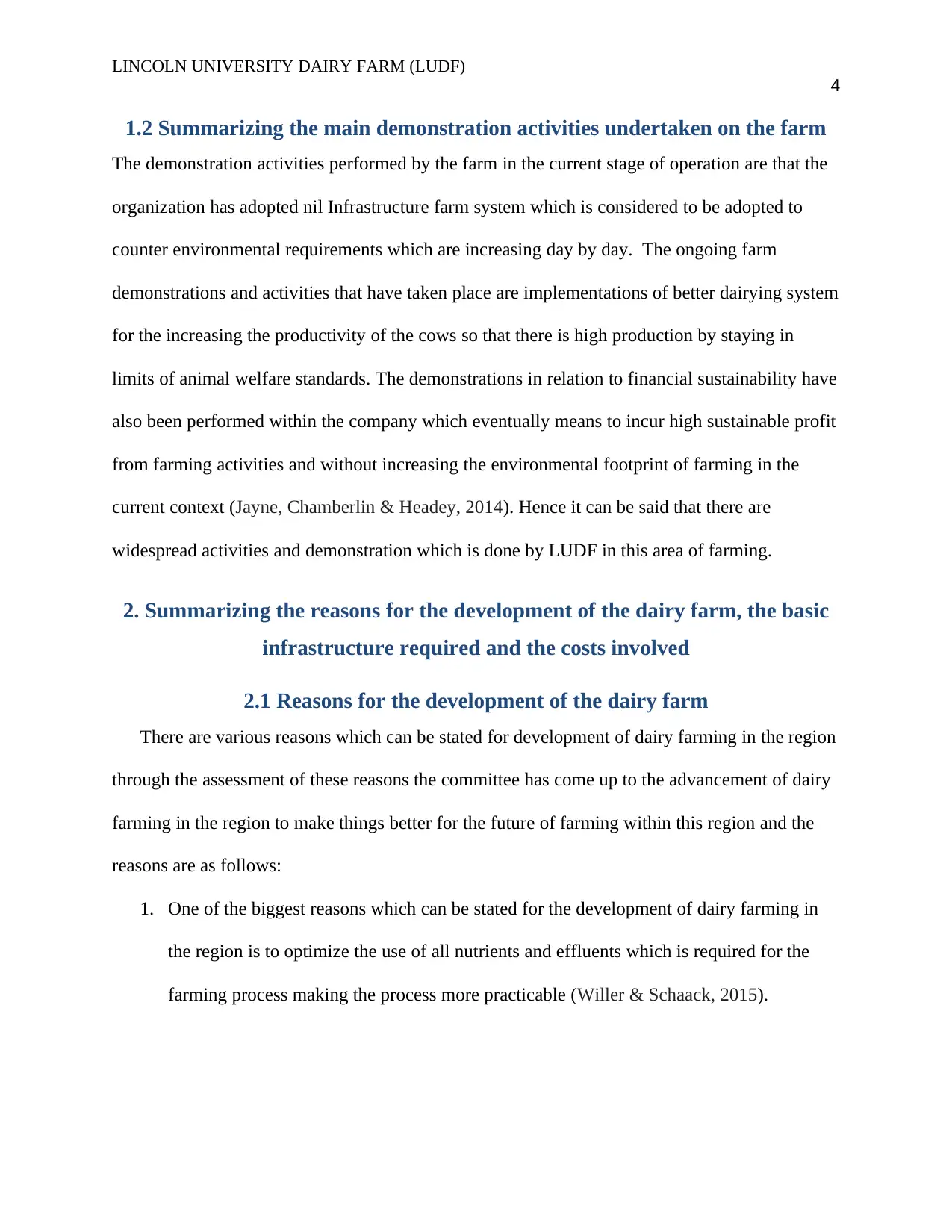
LINCOLN UNIVERSITY DAIRY FARM (LUDF)
4
1.2 Summarizing the main demonstration activities undertaken on the farm
The demonstration activities performed by the farm in the current stage of operation are that the
organization has adopted nil Infrastructure farm system which is considered to be adopted to
counter environmental requirements which are increasing day by day. The ongoing farm
demonstrations and activities that have taken place are implementations of better dairying system
for the increasing the productivity of the cows so that there is high production by staying in
limits of animal welfare standards. The demonstrations in relation to financial sustainability have
also been performed within the company which eventually means to incur high sustainable profit
from farming activities and without increasing the environmental footprint of farming in the
current context (Jayne, Chamberlin & Headey, 2014). Hence it can be said that there are
widespread activities and demonstration which is done by LUDF in this area of farming.
2. Summarizing the reasons for the development of the dairy farm, the basic
infrastructure required and the costs involved
2.1 Reasons for the development of the dairy farm
There are various reasons which can be stated for development of dairy farming in the region
through the assessment of these reasons the committee has come up to the advancement of dairy
farming in the region to make things better for the future of farming within this region and the
reasons are as follows:
1. One of the biggest reasons which can be stated for the development of dairy farming in
the region is to optimize the use of all nutrients and effluents which is required for the
farming process making the process more practicable (Willer & Schaack, 2015).
4
1.2 Summarizing the main demonstration activities undertaken on the farm
The demonstration activities performed by the farm in the current stage of operation are that the
organization has adopted nil Infrastructure farm system which is considered to be adopted to
counter environmental requirements which are increasing day by day. The ongoing farm
demonstrations and activities that have taken place are implementations of better dairying system
for the increasing the productivity of the cows so that there is high production by staying in
limits of animal welfare standards. The demonstrations in relation to financial sustainability have
also been performed within the company which eventually means to incur high sustainable profit
from farming activities and without increasing the environmental footprint of farming in the
current context (Jayne, Chamberlin & Headey, 2014). Hence it can be said that there are
widespread activities and demonstration which is done by LUDF in this area of farming.
2. Summarizing the reasons for the development of the dairy farm, the basic
infrastructure required and the costs involved
2.1 Reasons for the development of the dairy farm
There are various reasons which can be stated for development of dairy farming in the region
through the assessment of these reasons the committee has come up to the advancement of dairy
farming in the region to make things better for the future of farming within this region and the
reasons are as follows:
1. One of the biggest reasons which can be stated for the development of dairy farming in
the region is to optimize the use of all nutrients and effluents which is required for the
farming process making the process more practicable (Willer & Schaack, 2015).
Paraphrase This Document
Need a fresh take? Get an instant paraphrase of this document with our AI Paraphraser
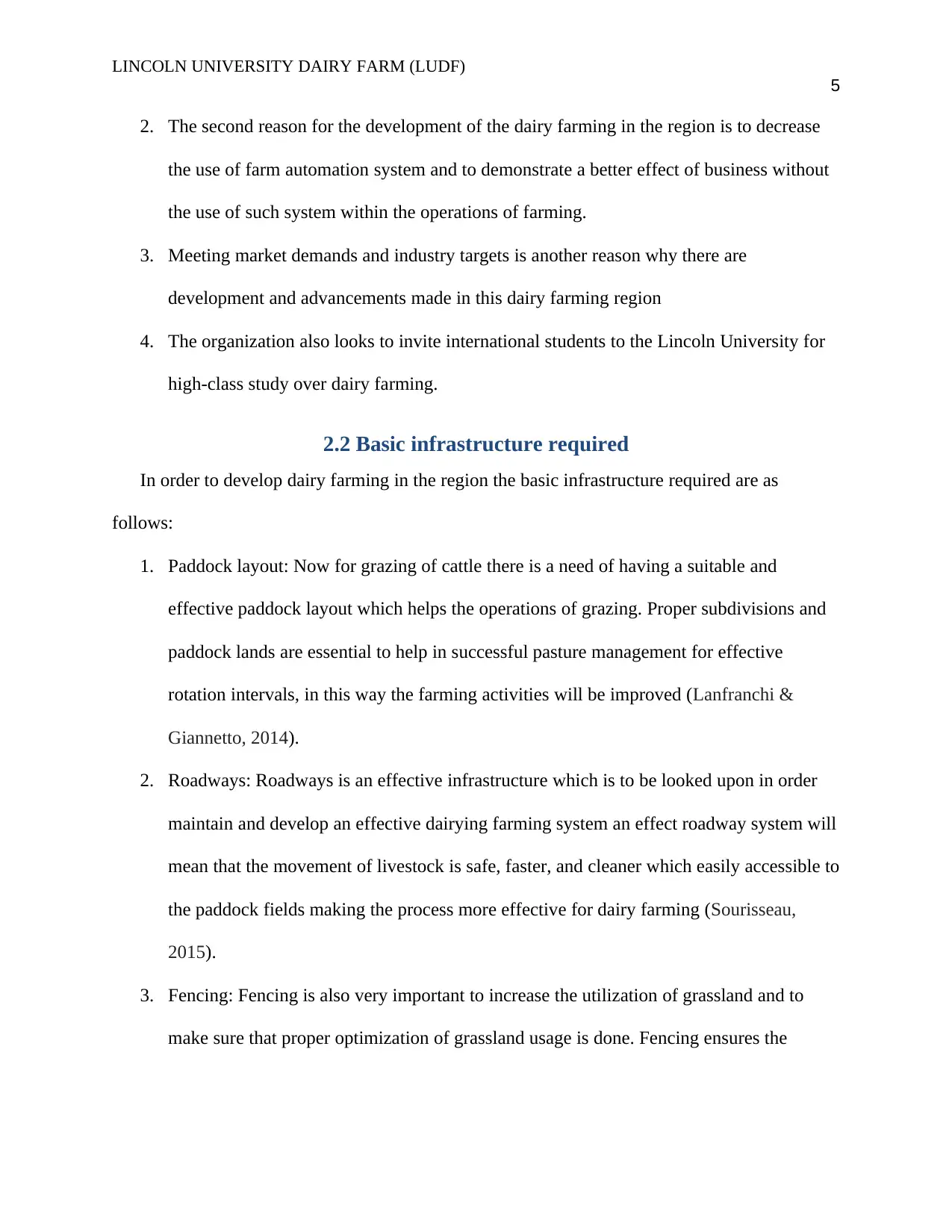
LINCOLN UNIVERSITY DAIRY FARM (LUDF)
5
2. The second reason for the development of the dairy farming in the region is to decrease
the use of farm automation system and to demonstrate a better effect of business without
the use of such system within the operations of farming.
3. Meeting market demands and industry targets is another reason why there are
development and advancements made in this dairy farming region
4. The organization also looks to invite international students to the Lincoln University for
high-class study over dairy farming.
2.2 Basic infrastructure required
In order to develop dairy farming in the region the basic infrastructure required are as
follows:
1. Paddock layout: Now for grazing of cattle there is a need of having a suitable and
effective paddock layout which helps the operations of grazing. Proper subdivisions and
paddock lands are essential to help in successful pasture management for effective
rotation intervals, in this way the farming activities will be improved (Lanfranchi &
Giannetto, 2014).
2. Roadways: Roadways is an effective infrastructure which is to be looked upon in order
maintain and develop an effective dairying farming system an effect roadway system will
mean that the movement of livestock is safe, faster, and cleaner which easily accessible to
the paddock fields making the process more effective for dairy farming (Sourisseau,
2015).
3. Fencing: Fencing is also very important to increase the utilization of grassland and to
make sure that proper optimization of grassland usage is done. Fencing ensures the
5
2. The second reason for the development of the dairy farming in the region is to decrease
the use of farm automation system and to demonstrate a better effect of business without
the use of such system within the operations of farming.
3. Meeting market demands and industry targets is another reason why there are
development and advancements made in this dairy farming region
4. The organization also looks to invite international students to the Lincoln University for
high-class study over dairy farming.
2.2 Basic infrastructure required
In order to develop dairy farming in the region the basic infrastructure required are as
follows:
1. Paddock layout: Now for grazing of cattle there is a need of having a suitable and
effective paddock layout which helps the operations of grazing. Proper subdivisions and
paddock lands are essential to help in successful pasture management for effective
rotation intervals, in this way the farming activities will be improved (Lanfranchi &
Giannetto, 2014).
2. Roadways: Roadways is an effective infrastructure which is to be looked upon in order
maintain and develop an effective dairying farming system an effect roadway system will
mean that the movement of livestock is safe, faster, and cleaner which easily accessible to
the paddock fields making the process more effective for dairy farming (Sourisseau,
2015).
3. Fencing: Fencing is also very important to increase the utilization of grassland and to
make sure that proper optimization of grassland usage is done. Fencing ensures the
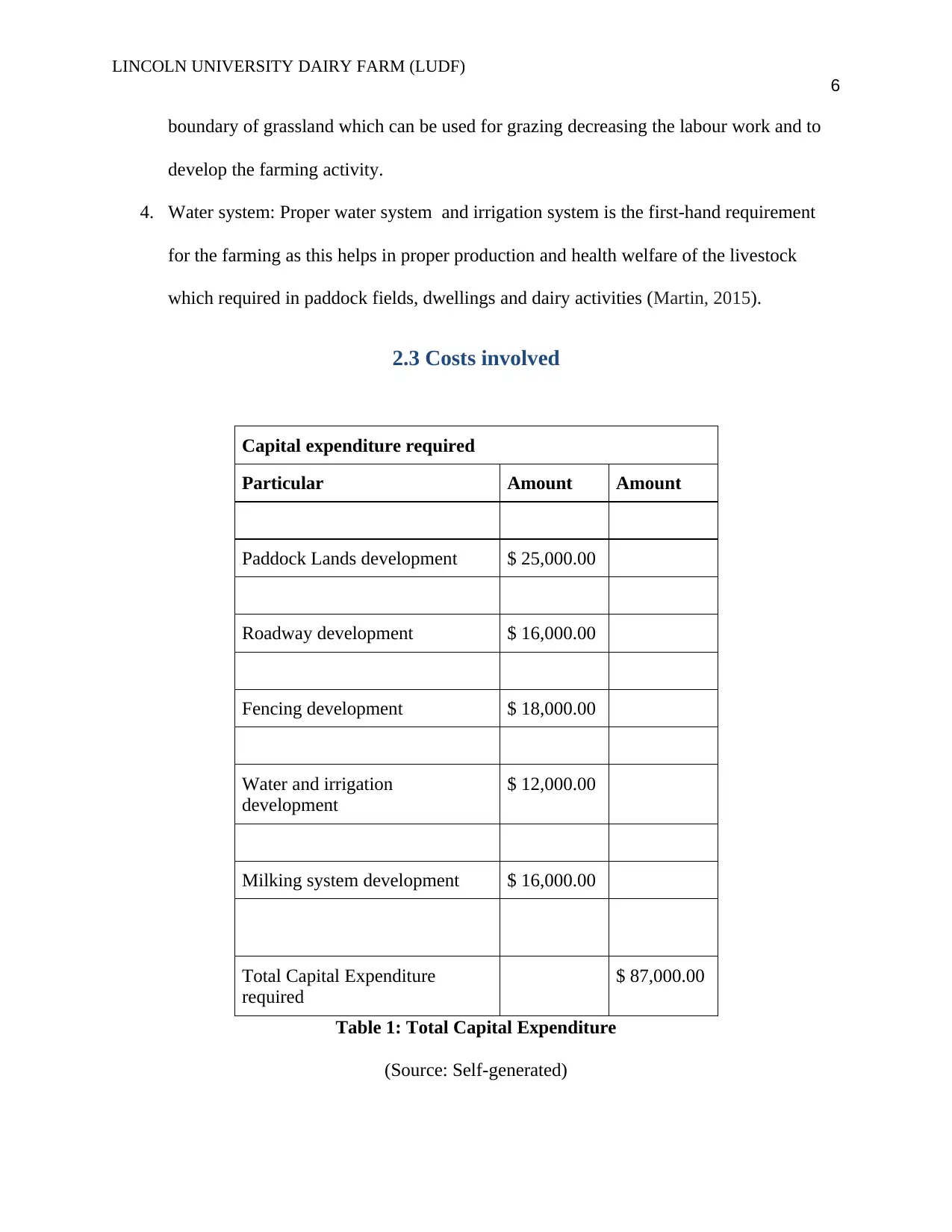
LINCOLN UNIVERSITY DAIRY FARM (LUDF)
6
boundary of grassland which can be used for grazing decreasing the labour work and to
develop the farming activity.
4. Water system: Proper water system and irrigation system is the first-hand requirement
for the farming as this helps in proper production and health welfare of the livestock
which required in paddock fields, dwellings and dairy activities (Martin, 2015).
2.3 Costs involved
Capital expenditure required
Particular Amount Amount
Paddock Lands development $ 25,000.00
Roadway development $ 16,000.00
Fencing development $ 18,000.00
Water and irrigation
development
$ 12,000.00
Milking system development $ 16,000.00
Total Capital Expenditure
required
$ 87,000.00
Table 1: Total Capital Expenditure
(Source: Self-generated)
6
boundary of grassland which can be used for grazing decreasing the labour work and to
develop the farming activity.
4. Water system: Proper water system and irrigation system is the first-hand requirement
for the farming as this helps in proper production and health welfare of the livestock
which required in paddock fields, dwellings and dairy activities (Martin, 2015).
2.3 Costs involved
Capital expenditure required
Particular Amount Amount
Paddock Lands development $ 25,000.00
Roadway development $ 16,000.00
Fencing development $ 18,000.00
Water and irrigation
development
$ 12,000.00
Milking system development $ 16,000.00
Total Capital Expenditure
required
$ 87,000.00
Table 1: Total Capital Expenditure
(Source: Self-generated)
⊘ This is a preview!⊘
Do you want full access?
Subscribe today to unlock all pages.

Trusted by 1+ million students worldwide
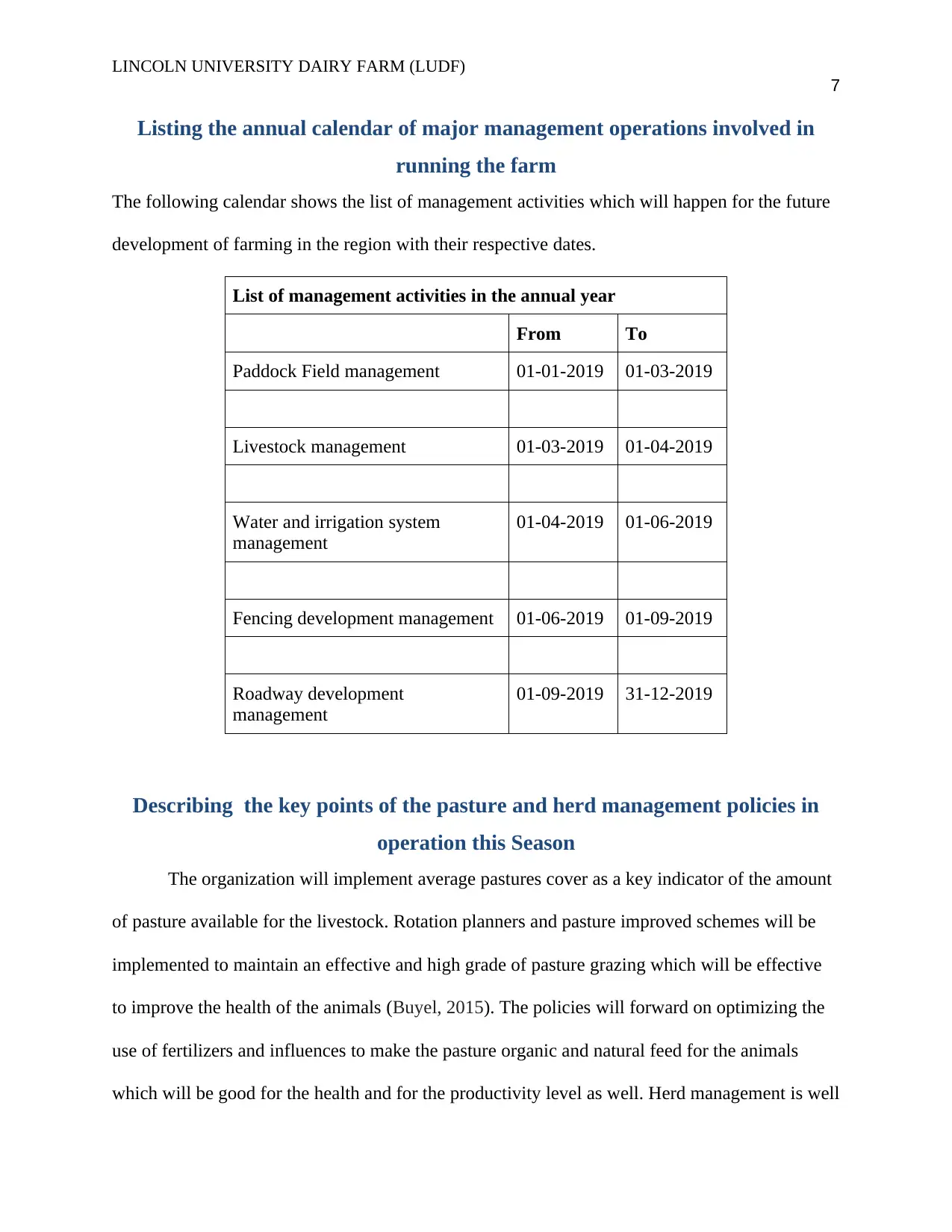
LINCOLN UNIVERSITY DAIRY FARM (LUDF)
7
Listing the annual calendar of major management operations involved in
running the farm
The following calendar shows the list of management activities which will happen for the future
development of farming in the region with their respective dates.
List of management activities in the annual year
From To
Paddock Field management 01-01-2019 01-03-2019
Livestock management 01-03-2019 01-04-2019
Water and irrigation system
management
01-04-2019 01-06-2019
Fencing development management 01-06-2019 01-09-2019
Roadway development
management
01-09-2019 31-12-2019
Describing the key points of the pasture and herd management policies in
operation this Season
The organization will implement average pastures cover as a key indicator of the amount
of pasture available for the livestock. Rotation planners and pasture improved schemes will be
implemented to maintain an effective and high grade of pasture grazing which will be effective
to improve the health of the animals (Buyel, 2015). The policies will forward on optimizing the
use of fertilizers and influences to make the pasture organic and natural feed for the animals
which will be good for the health and for the productivity level as well. Herd management is well
7
Listing the annual calendar of major management operations involved in
running the farm
The following calendar shows the list of management activities which will happen for the future
development of farming in the region with their respective dates.
List of management activities in the annual year
From To
Paddock Field management 01-01-2019 01-03-2019
Livestock management 01-03-2019 01-04-2019
Water and irrigation system
management
01-04-2019 01-06-2019
Fencing development management 01-06-2019 01-09-2019
Roadway development
management
01-09-2019 31-12-2019
Describing the key points of the pasture and herd management policies in
operation this Season
The organization will implement average pastures cover as a key indicator of the amount
of pasture available for the livestock. Rotation planners and pasture improved schemes will be
implemented to maintain an effective and high grade of pasture grazing which will be effective
to improve the health of the animals (Buyel, 2015). The policies will forward on optimizing the
use of fertilizers and influences to make the pasture organic and natural feed for the animals
which will be good for the health and for the productivity level as well. Herd management is well
Paraphrase This Document
Need a fresh take? Get an instant paraphrase of this document with our AI Paraphraser
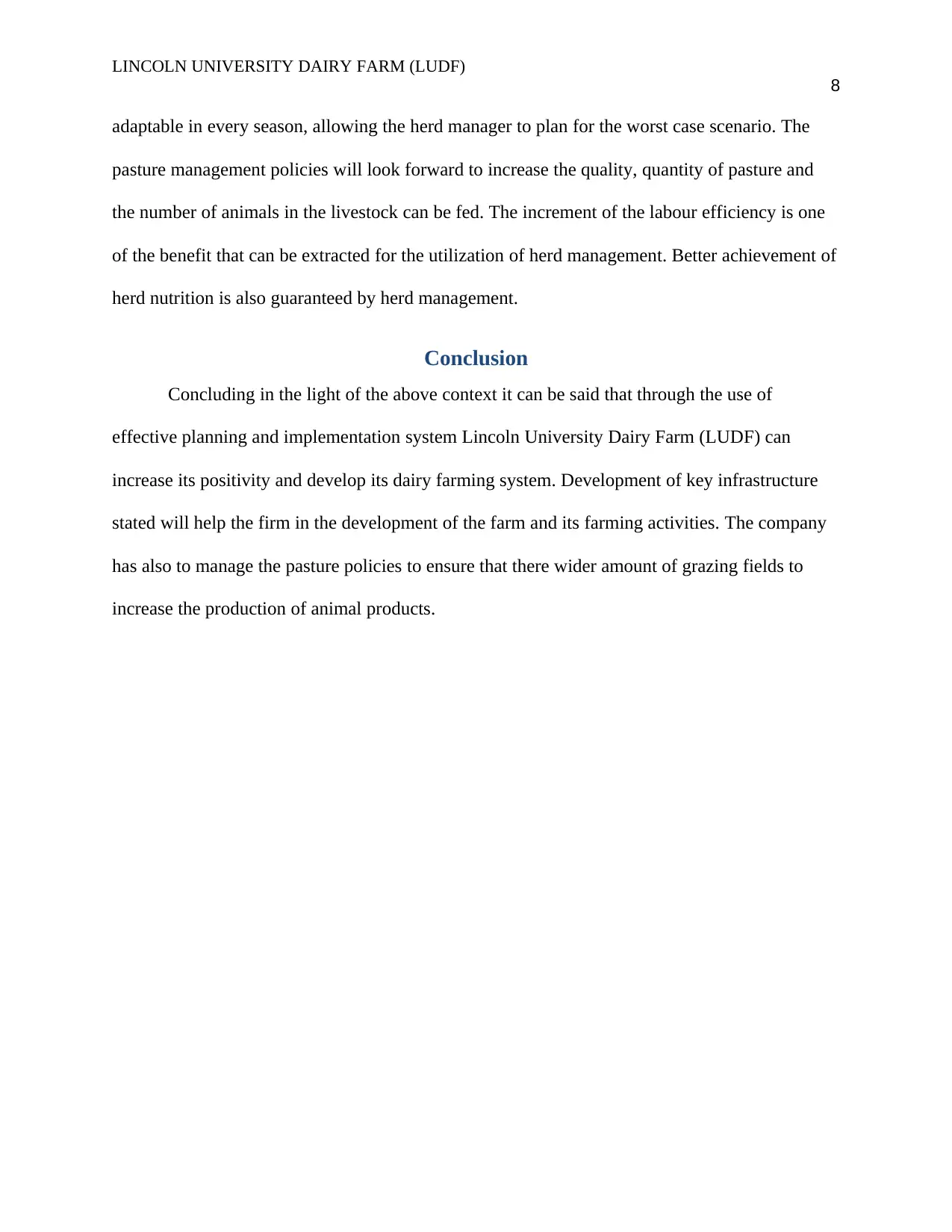
LINCOLN UNIVERSITY DAIRY FARM (LUDF)
8
adaptable in every season, allowing the herd manager to plan for the worst case scenario. The
pasture management policies will look forward to increase the quality, quantity of pasture and
the number of animals in the livestock can be fed. The increment of the labour efficiency is one
of the benefit that can be extracted for the utilization of herd management. Better achievement of
herd nutrition is also guaranteed by herd management.
Conclusion
Concluding in the light of the above context it can be said that through the use of
effective planning and implementation system Lincoln University Dairy Farm (LUDF) can
increase its positivity and develop its dairy farming system. Development of key infrastructure
stated will help the firm in the development of the farm and its farming activities. The company
has also to manage the pasture policies to ensure that there wider amount of grazing fields to
increase the production of animal products.
8
adaptable in every season, allowing the herd manager to plan for the worst case scenario. The
pasture management policies will look forward to increase the quality, quantity of pasture and
the number of animals in the livestock can be fed. The increment of the labour efficiency is one
of the benefit that can be extracted for the utilization of herd management. Better achievement of
herd nutrition is also guaranteed by herd management.
Conclusion
Concluding in the light of the above context it can be said that through the use of
effective planning and implementation system Lincoln University Dairy Farm (LUDF) can
increase its positivity and develop its dairy farming system. Development of key infrastructure
stated will help the firm in the development of the farm and its farming activities. The company
has also to manage the pasture policies to ensure that there wider amount of grazing fields to
increase the production of animal products.
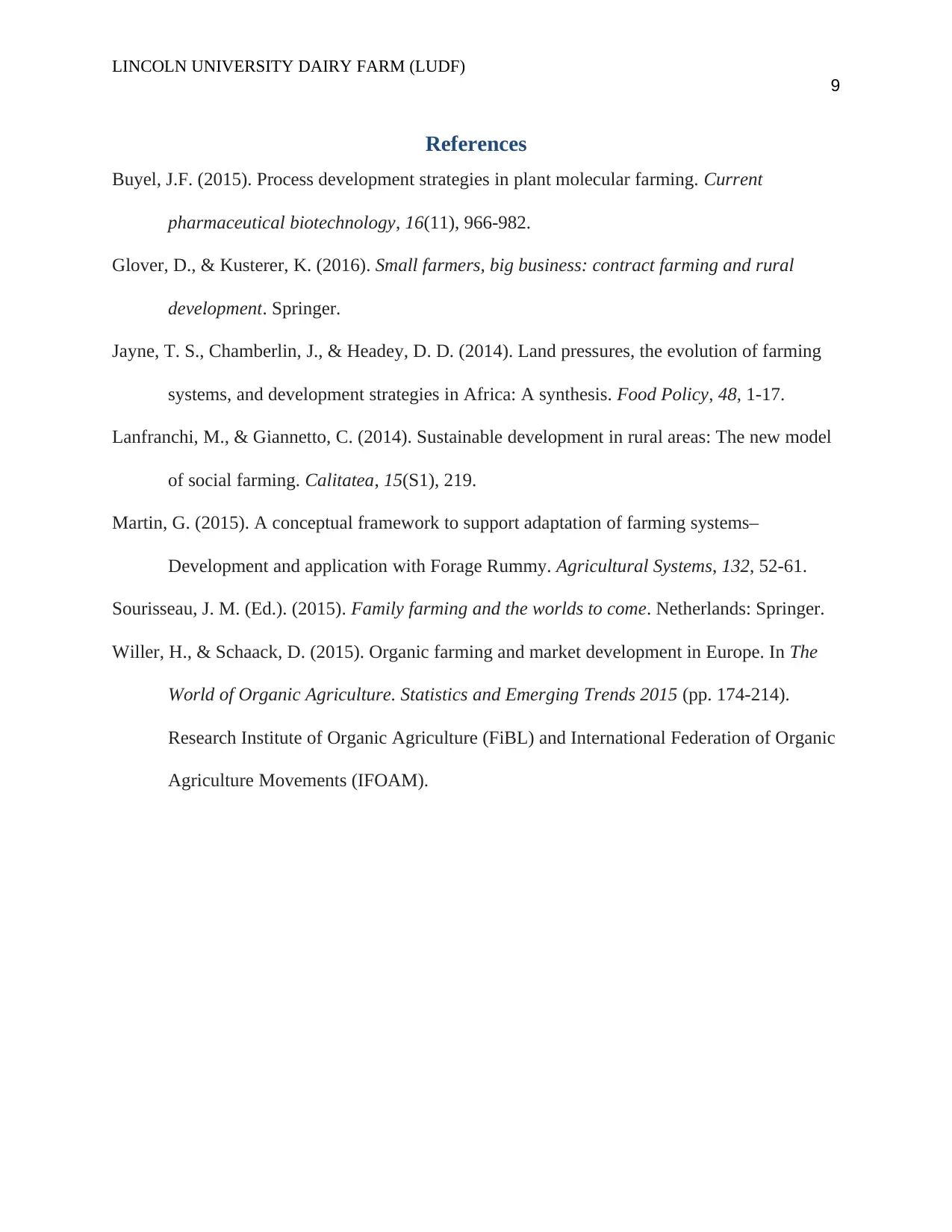
LINCOLN UNIVERSITY DAIRY FARM (LUDF)
9
References
Buyel, J.F. (2015). Process development strategies in plant molecular farming. Current
pharmaceutical biotechnology, 16(11), 966-982.
Glover, D., & Kusterer, K. (2016). Small farmers, big business: contract farming and rural
development. Springer.
Jayne, T. S., Chamberlin, J., & Headey, D. D. (2014). Land pressures, the evolution of farming
systems, and development strategies in Africa: A synthesis. Food Policy, 48, 1-17.
Lanfranchi, M., & Giannetto, C. (2014). Sustainable development in rural areas: The new model
of social farming. Calitatea, 15(S1), 219.
Martin, G. (2015). A conceptual framework to support adaptation of farming systems–
Development and application with Forage Rummy. Agricultural Systems, 132, 52-61.
Sourisseau, J. M. (Ed.). (2015). Family farming and the worlds to come. Netherlands: Springer.
Willer, H., & Schaack, D. (2015). Organic farming and market development in Europe. In The
World of Organic Agriculture. Statistics and Emerging Trends 2015 (pp. 174-214).
Research Institute of Organic Agriculture (FiBL) and International Federation of Organic
Agriculture Movements (IFOAM).
9
References
Buyel, J.F. (2015). Process development strategies in plant molecular farming. Current
pharmaceutical biotechnology, 16(11), 966-982.
Glover, D., & Kusterer, K. (2016). Small farmers, big business: contract farming and rural
development. Springer.
Jayne, T. S., Chamberlin, J., & Headey, D. D. (2014). Land pressures, the evolution of farming
systems, and development strategies in Africa: A synthesis. Food Policy, 48, 1-17.
Lanfranchi, M., & Giannetto, C. (2014). Sustainable development in rural areas: The new model
of social farming. Calitatea, 15(S1), 219.
Martin, G. (2015). A conceptual framework to support adaptation of farming systems–
Development and application with Forage Rummy. Agricultural Systems, 132, 52-61.
Sourisseau, J. M. (Ed.). (2015). Family farming and the worlds to come. Netherlands: Springer.
Willer, H., & Schaack, D. (2015). Organic farming and market development in Europe. In The
World of Organic Agriculture. Statistics and Emerging Trends 2015 (pp. 174-214).
Research Institute of Organic Agriculture (FiBL) and International Federation of Organic
Agriculture Movements (IFOAM).
⊘ This is a preview!⊘
Do you want full access?
Subscribe today to unlock all pages.

Trusted by 1+ million students worldwide
1 out of 9
Related Documents
Your All-in-One AI-Powered Toolkit for Academic Success.
+13062052269
info@desklib.com
Available 24*7 on WhatsApp / Email
![[object Object]](/_next/static/media/star-bottom.7253800d.svg)
Unlock your academic potential
Copyright © 2020–2025 A2Z Services. All Rights Reserved. Developed and managed by ZUCOL.





